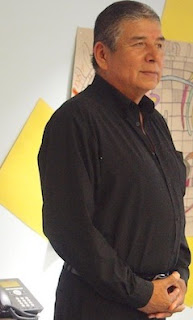Now exhibiting at PAMA in Brampton, Ontario
-
Mishibinijima, The
Last Artist Standing
(And Still Painting
Really Good Stuff)
Manitoulin Island artist
James Simon Mishibinijima’s life path is about survival. His mother’s stories
of her harrowing past in a residential school and his own survival as one of
the last working artists from the first wave of Woodland First Nations’ Art
movement
At a time when his
contemporaries (i.e Carl Ray, Arthur
Schilling, Carl Beam and Daphne Odjig) are falling off the mortal coil, 63 year old Mishibinijima
continues to be a First Nations inspirational artistic force. His work is in
constant demand from arts institutions, private galleries, museums, and
currently can be seen at PAMA – Brampton, Ontario’s and Peel Region’s public
gallery. A series of his paintings in the current Peel 150 exhibition is entitled
“Indian Residential School Paintings”. They tell Mishibinijima’s mother’s
stories as she gave them to him and as they revealed themselves in his dreams.
Her stories are depicted as pictographs.
“These paintings’
deceptively simple style provide the maximum opportunities for someone
experiencing his paintings, particularly children and young adults, to reflect
on this tragic chapter in our nation’s history and to understand the pain and
trauma that people their own age experienced,” explains author and curator Tom
Smart. “Mishibinijima’s paintings are intended to open dialogues about personal
and community values, and about the need to confront the truth.”
Mishibinijima
began showing his work in 1969 at a time when the world was enthralled with the
works of Woodland First Nations’ artists.
Just15 years old, his paintings were being compared with the likes of
the older, more established artists, such as the members of the Indian Group of Seven - Daphne Odig, Alex Javier, Jackson Beardy, Eddy Cobiness, Norval Morrisseau, Carl Ray and American born Joseph Sanches.
We met back in
1983. I was helping with the promotion of his first exhibition at the Whetung
Art Gallery in the Curve Lake First Nation. He was billed as the artist James
Simon (although he would usually sign his paintings as Mishibinijima). Growing
up in Wikwemikong, one of the few Unceded Territories in Canada, he had been
given the name James Alexander Simon by missionaries who found his First
Nations’ name Mishibinijima difficult to pronounce.
We didn’t talk
much at that seminal art exhibition and sale beyond how crazy busy it was. There were interviews with the media and a
long line of art buyers who made the two-hour trek to the reserve north from
Toronto to snap up any James Simon painting before the log gallery walls were
covered in red sold stickers!
Busy Busy Busy.
Within a year his paintings were touring public galleries in America, Austria
and Germany. It wasn’t long before he found that he could best answer the
European demand for his work by moving to Germany.
He became the toast of Berlin, had an audience with Pope Paul the Second, and was
very, very successful.
His following is
still strong in Europe but he and wife, Jean, felt the need to come back to Manitoulin
Island on a full-time basis. They now operate the Mishibinijima Private Gallery
in their home town of Wikwemikong.
VIDEO - George Socka interviewed the artist during the show's installation. Press here to watch the 2-minute YouTube. https://youtu.be/jegqMHz3YUA







Comments